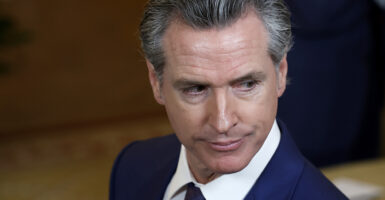This Earth Day, which falls on Monday, California residents must be glad that their state accounts for less than 1% of the greenhouse gas emissions of the top 50 countries. Yet Gov. Gavin Newsom, a Democrat, still wants to achieve 100% net-zero carbon electricity by 2045.
With the highest effective poverty rate in America and some of the nation’s highest electricity costs, Newsom’s top priority should be to shift to energy affordability.

The intermittency of renewables such as solar and wind is one reality plaguing the Golden State. Another is the fact that the state’s transmission lines are sparking many wildfires, exacerbating problems with an increasingly strained and poorly maintained electrical grid.
In October 2017, Pacific Gas and Electric Co.’s equipment caused 16 fires in California. By 2021, California experienced roughly 7,000 wildfires, some still resulting from trees and other flammable detritus hanging on transmission lines, which are PG&E’s responsibility to remove.
The Gordon and Betty Moore Foundation has estimated that “average annual losses” resulting from wildfires from 2017 through 2021 totaled over $117.4 billion. These incidents have led to numerous lawsuits against the utility and repeated bankruptcy restructurings.
As part of the bankruptcy reorganization plan, PG&E was forced to adopt an Enhanced Oversight and Enforcement Process to manage vegetation. Despite missing every fire-risk-reduction target of its bankruptcy reform, the utility claimed that it couldn’t afford to keep its 5,500 tree trimmers on payroll. Instead, it wanted to distribute over $187 million in stock bonuses to the top 400 executives and employees—almost half a million dollars per recipient.
Facing financial strain and pressure to transition to renewables, the utility raised rates and saw profits increase by 25% in 2023. Over the past 10 years, PG&E customers have seen rates increase 127%, disproportionately affecting the poor, small businesses, and farmers.
Additionally, the Californian Public Utility Commission adopted new guidelines on net energy metering, which drastically reduced payouts for rooftop photovoltaic solar panels. Due to these needed reforms, rooftop solar sales have declined by about three-quarters since 2022. Currently, 75% of solar installers are considered “high risk,” with over 100 companies already filing for bankruptcy.
Despite these regular curtailments of solar panels, a joint report from the California Air Resources Board and other state agencies anticipates that electricity generation capacity will need to triple by 2045 to meet the state’s net-zero carbon goal.
Since solar and wind output vary with weather and time of day, California’s power grid will rely more on carbon-intensive natural gas “peaker” plants rather than on low-carbon, combined-cycle natural gas plants and carbon-free nuclear plants.
State law now requires zero-emission vehicle sales to be 35% of total sales by 2026 and 100% by 2035. Some have equated these energy policies to a new “Green Jim Crow,” as the policy disproportionately will impoverish the most disadvantaged Californian communities. The Public Policy Institute of California found that nearly a third of Californians live in or near poverty, and this policy will only exacerbate this situation.
If Newsom’s vehicle regulations are fully implemented, California would require drastically more electricity.
The California Energy Commission projects that transitioning to electric vehicles would require an additional 1.2 million charging stations by 2030 to accommodate the mandated 7.5 million EVs.
With a deficit of 54,000 installations in 2021, the goal of 250,000 chargers by 2025 is already out of reach, even with the $63 million federal grant approved in January.
This policy malfeasance of requiring massive electrification without drastically increasing grid capacity already has been felt. In August 2022, shortly after Newsom’s electric vehicle rule became state law, California faced a 10-day power shutdown. Subsequently, the governor announced that citizens should refrain from charging their electric cars—a few days after Biden Energy Secretary Jennifer Granholm praised Newsom for pursuing his green energy agenda.
Newsom’s green energy policy experiments, such as the 2022 comprehensive energy bill, could result in an additional electricity cost of $830 a year per person to California residents. Only reality stands in the way of his plan for a net-zero power grid and automobile fleet by 2045.
Newsom’s policies have cost state residents almost a million jobs over the past five years. Millions of Californians have left for other states, with almost two-thirds of Californians considering following them.
Despite the increase in energy and transportation costs that will result if similar policies are pursued nationally, the Environmental Protection Agency has taken Newsom’s lead with its new tailpipe rule, which would mandate that 70% of new vehicles sold will be electric plug-in capable by 2032.
As we observe Earth Day on April 22, we should hope that any emulation of the failed Californian experiment will be stopped before such bad policy experiments further reduce economic growth.
Originally published by the Daily Caller News Foundation


























